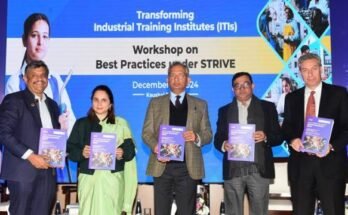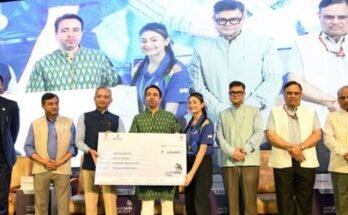Skilling has been one of the most focused agenda of Government of India for the last few years. India is targeting to equip 400 million youth (by 2022) with industry relevant skills in multiple trades/sectors through various skill programs/schemes implemented at skilling institutions such as Skill Development Centers (SDCs), Vocational Training Providers (VTPs), Industrial Training Institutes (ITIs), and Polytechnics/Engineering Colleges etc. Initiatives like “Make in India”, “Digital India” etc. are creating job opportunities in key manufacturing and service sectors of the economy thereby, demanding quality skilled manpower.
However, a significant gap exists between the demand for skilled manpower and the supply of such manpower through skilling institutions such as ITIs. Apart from this, 12 million people enter the workforce every year who not only need to have jobs, but who also need to have the required skills for different job roles. While this is a large number in itself, added to this is the complexity that about 93% of workers are in the informal sector which is transient in nature.
NEED FOR GRADING OF ITIs
1.1 The Government’s vocational training programs are primarily managed by the ITIs which cater to about 36% of the 7 million people getting trained in India today. The first ITI was set up in 1950 and the number today stands at 13,348 (including both government and private ITIs)1 providing vocational training to around 19 lakh youths in 126 trades. With such a speedy increase in number of ITIs, it is necessary to have a standard “quality assurance mechanism” in place. To ensure the quality checks of these institutes, Directorate General of Training (DGT) – Ministry of Skill Development and Entrepreneurship (MSDE) – has decided to grade the ITIs on the basis of some key parameters. The grading shall provide a “benchmark for comparison” amongst the institutes.
1.2 The National Policy on Skill Development and Entrepreneurship, 2015 also emphasizes on rating of ITIs. It states that “Performance rating of ITIs will also be promoted based on outcome linked parameters and trainee/employer feedback”.
1.3 The objective of conducting grading exercise for ITIs is to provide “Star Rating” to the performing institutes and give an opportunity to the institutes lagging behind in some of the parameters, to improve upon. The scoring shall be done against each of the defined parameters. The final rating of the institute shall determine its current performance level and shall enable them to find out the key areas where they can improve further, so as to get higher rating during next grading process.
1.4 Further, MSDE aims to identify at least 500 ITIs to become “World Class” training institutes which are recognized for their training standards and practices, not just in India but abroad. These ITIs will act as model institutes for others to emulate and will provide strategic direction to industrial training in India. In addition, students of such ITIs shall be given preference for training opportunities outside India through various collaborative efforts of Government of India with other countries. The rating of these best institutes will be declared and displayed separately to support their improved positioning in skills ecosystem.
GRADING FRAMEWORK
2.1 The grading process shall be voluntary in nature and only those ITIs desirous of obtaining rating under this framework shall be required to submit/upload information/data for the purpose. However, ITIs opting out of grading process shall be denied benefits/incentives (outlined in section 6 of this document) and shall not be allowed to add new trades/courses.
2.2 A comprehensive “framework” has been designed to detail out the key parameters on which the performance of each of the institutes shall be evaluated and graded accordingly. The primary purpose of this framework is to galvanize ITIs towards a competitive environment so as to improve their current operational performance. Clear definition and identification of key parameters shall help ITIs to work candidly towards maintaining the highest level of performance standards and further improving their rating. These parameters are strong pointers of “quality of training” being imparted at ITIs across the country.
2.3 The parameters (total 43) are grouped under 10 heads such as civil work, trades, industry connect, outcome, instructors, production center, capacity utilization, key compliances, special achievement, and miscellaneous. Essentially, the grading parameters would evaluate the civil work of the institute in terms of building completion, rented or owned building etc.; status of Institute Management Committee (IMC) and the level of institute-industry engagement; availability and specification of machines, tools and equipment as per DGT norms; availability of high-end machines; availability of qualified instructors as per DGT norms; instructor vacancy; availability of full-time principal; availability of books; drop-out rate; placements; pass-out ratio; capacity utilization; availability of high-end trade; industry involvement in delivering guest lectures; diversity in revenue streams, amongst other things.
2.4 The detailed “grading parameters” along with “information/data to be provided”, “metrics”, and “weights” assigned to each parameter has been provided in Annexure I.
2.5 The DGT (MSDE) reserves the right to modify any of the metrics if it deems fit to do so in the interest of various stakeholders. Any changes so made will be notified at the time of announcing the ratings.
GRADING METHODOLOGY
3.1 The methodology is based on developing a set of metrics for rating of ITIs, based on the parameters agreed upon by DGT (MSDE).
3.2 An attempt is also made to identify the relevant data needed to suitably measure the performance rating under each parameter. Here the emphasis is on identifying data that an ITI can easily provide and can be easily verifiable, where verification is needed. This is important in the interest of transparency.
3.3 A suitable metric is then proposed based on this data, basis which a rating is given under each parameter. The parameters have appropriate weight assigned to them. The parameter ratings are then added to obtain rating for each individual head.
3.4 The methodology for grading of ITIs shall include following steps:
Step 1: DGT (MSDE) shall invite ITIs who volunteer to participate in the grading exercise. Interested ITIs shall rate themselves on grading parameters defined in Annexure I. This shall be enabled using assigned User ID and Password through a web-link in NCVT2 MIS portal. On the ratings web-page, ITIs will be able to mention “actual value” of the data/information against each parameter. The self-rating; corresponding mention of data/information; shall be carried out by ITI.
It is also desirable that ITIs upload the submitted data and relevant documents on their publicly visible website in the interest of transparency.
If self-rating of an ITI is not as per actual data/information submitted then DGT reserves the right to provide Zero rating to that ITI.
Step 2: Various users such as Trainees, Parents, Faculty, Employers, and Others (which may include other stakeholders and unidentified users) shall rate an ITI on same grading parameters (defined in Annexure I) through a NCVT MIS Portal. The self-rating of ITI will be visible to users. The objective of this step is to get a calibrated view through eliciting feedback from key stakeholders.
It may further be noted that rating given by unidentified users will not be counted towards temporary or final rating.
Step 3: “NCVT Sub-Committee on Affiliation” shall scrutinize the rating data and provide “Temporary” Star (*) rating to an ITI giving “70% weightage to ITI self-rating; and 30% weightage to rating from other stakeholders and users”.
Step 4: The grading framework will be used for all routine inspections carried out by DGT officials as well by State government officials. All such inspection reports will be loaded on the NCVT MIS rating portal. The DGT may assign an “official” to visit select ITIs, validate the submitted data and provide rating against same grading parameters through their respective “log-in” facility in NCVT MIS portal. The self-rating given by an ITI and by various users along with comments/remarks shall be visible to assigned official while giving rating. Further, DGT/State official should be able to provide comments/remarks while giving rating to an ITI. The record of comments/remarks shall form the “base” for future inspections of ITIs against the existing grading parameters or changed parameters (after appropriate revisions in future). The inspection shall be a continuous process after ITI self-rating. Furthermore, rating given by DGT / State officials will be counted as part of user rating.
Step 5: The “external agency/s” (selected through an open tender process) shall visit all the ITIs (under consideration for grading); conduct physical verification of infrastructure, machines, tools and equipment, trainers, documents etc.; validate the data uploaded by ITI; recommend a “Star Rating” for each ITI; and submit the report to DGT. The external agency should also be able to apply analytical tools & techniques to analyse the ITI data and provide meaningful insights on ITI performance in its report.
Step 6: A “Core Grading Committee” shall recommend to DGT the final rating of each ITI based on the report submitted by external agency. The core grading committee may consist of 4 members headed by an external expert. Other members may include representatives from DGT, Ministry of Human Resource Development (MHRD), National Assessment and Accreditation Council (NAAC). Based on the recommendations of committee, DGT shall publish the final ratings.
3.5 The final “Star Rating” obtained through grading mechanism shall be displayed on the website of ITI, DGT website, and NVCT MIS Portal. Further, all graded ITIs shall display rating on their institute’s signboard.
3.6 A suitable mechanism shall be developed to display the ITI rating on NCVT certificate of pass-out trainees.
3.7 MSDE/DGT shall carry out an “independent external audit” (based on random sampling of ITIs) of entire grading process, inspection reports and comments/remarks to ensure quality assurance of entire process; and to establish the veracity of claims/statements made and data/information/document collected in relation to grading.
3.8 If it is found that an ITI has deliberately manipulated the submitted data, causing erroneous rankings, DGT (MSDE) will remove the ITI from the rating list and publish a suitable note to this effect.
3.9 If an ITI loses its affiliation status at any point of time, it also loses its rating.
To read complete Framework and Grading system of ITI, download complete report here (Click Here)



